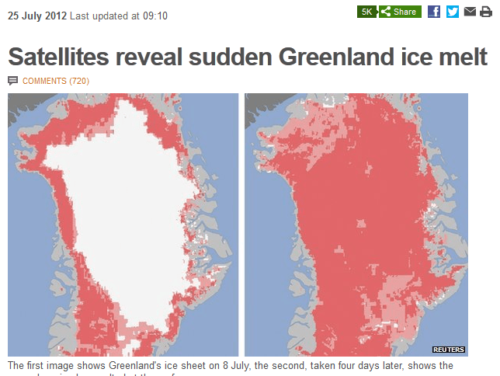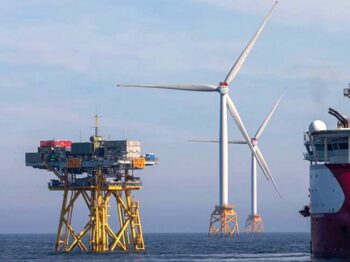We are all familiar with tales of “heatwaves” and meltdowns in Greenland.
However, data from DMI tells a totally different story.
They publish daily temperatures data for two of the long-running stations in Greenland, Ilulissat, and Tasilaq:
Ilulissat (station 4221) is on the west coast and Tasilaq (4360) on the east:
Below are the charts of the hottest days on record:
http://www.dmi.dk/laer-om/generelt/dmi-publikationer/2013/
Tasilaq, because of its more southerly location, gets higher temperatures, but at neither site is there any evidence of temperatures spiraling upwards.
According to DMI, the all-time record is slightly higher than those 25°Cs (77F) at Tasilaq:
The warmest temperature recorded in Greenland since 1958 was 25.9°C (78.62F) in July 2013 in Manitsoq at the West Greenland coast.
http://www.dmi.dk/en/klima/klimaet-frem-til-i-dag/groenland/
But Manitsoq is in the warmest SW tip of the country, and cannot be directly compared with Tasilaq.
As DMI also point out, Foehn winds are very common, and can lift temperatures by 30°C (86F) in a relatively short time:
The Foehn wind can disturb this picture in winter. Foehn winds are very common in Greenland. In winter, the warm and dry winds can cause temperatures to rise by 30°C (86F) in a relatively short time causing snow and ice to melt.
http://www.dmi.dk/en/klima/klimaet-frem-til-i-dag/groenland/
And in their report on the Manitsoq record, DMI confirm that it was Foehn winds that were responsible:
Irish day offered the highest temperature measured at an official Greenlandic airport weather station – the records date back to 1958.
On July 30, 2013, at 16 o’clock in the afternoon, the official Greenland airport station Maniitsoq / Sukkertoppen measured 25.9°C (78.62F). Maniitsoq is a few hundred kilometers north of Nuuk on the southwest coast of Greenland.
25.9°C (78.62F) is the highest temperature at a weather station DMI has data since the records began in 1958. The previous highest temperature and current weather record of 25.5°C (77.9F) was from 27 July 1990 at Kangerlussuaq, located in the same area of Greenland.
Whether or not the 25.9°C (77.9F) later increases to a new record for Greenland, will only be decided after a further climatological study of the conditions.
A high pressure across Greenland combined with a low pressure over Baffin Island gave predominantly southeastern wind and thus the possibility of a fohn effect. It is confirmed that the air was very dry with a relative humidity of less than 20%.
The station Maniitsoq/Sukkertoppen lies by the sea and the sun’s ocean reflections in the afternoon may have contributed to the high temperatures, as well as various other local conditions may have arisen.
http://www.dmi.dk/nyheder/arkiv/nyheder-2013/8/groenland-saetter-temperaturrekord/
Note as well that Manitsoq’s record only goes back to 1958, so similar temperatures may well have been set previously.
Alarmists like to feed the impression that it rarely gets above freezing in Greenland, and temperatures in the 70s (F) must be due to global warming. In fact, they are perfectly common and natural.
Read more at Not A Lot Of People Know That























So Greenland gets a little heat and the Climate Change nutcases are blaming Trump for puling America out of the Paris Accord or blaming Americans for voting for Trump like some dim-bulb did last year after those two Hurricanes Harvey and Irma